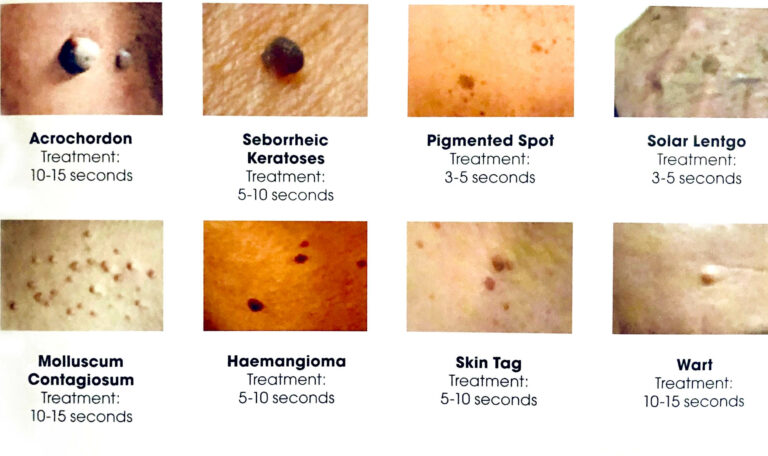Cryotherapy
Cryotherapy – treatment for a range of skin lesions by freezing them without the need for surgery.
CryoPen™ is an advanced cryotherapy innovation that is a fast, effective, safe and new solution for removal of skin imperfections. Procedures typically last from 5 to 25 seconds, so you can be in and out of the clinic quickly.
The CryoPen™ emits a fine jet of nitrous oxide under high pressure, which allows the clinician to work with millimetre precision. This destroys the tissue by freezing the inter-cellular fluid, forming ice shards and crystals which rupture the membrane, thereby destroying the cell. That means there will be no collateral damage to healthy tissue. It’s so incredibly accurate and practical.
CryoPen™ offers the ideal treatment for: Skin Tag Removal, Solar Lentigo, Age Spots, Milia, Warts, Cherry Angioma, Viral Verrucas.


Cryotherapy works by causing the water in the skin cells to freeze. As this happens the water expands (setting up a crystalline matrix) and then fractures the frozen cell walls causing cellular necrosis. This freeze also destroys the nucleus of the cell, and there can be no revival, and the cells within the skin lesion are removed. There is mild local pain during the procedure, but the procedure does not normally require any local anaesthetic. The frozen skin turns white and slowly thaws to normal skin colour. Over the following few days, a scab or a blister may form, which will fall off. The treated area eventually looks normal, but can sometimes leave a paler or darker mark. More than one treatment may be necessary. This again depends on the size and thickness of the skin lesion.
1) INFLAMMATION The treatment process causes the cells to be injured by freezing. This injury causes an increase in blood flow to the area showing as a reddening of the areas inflammation. The increase bring with it chemicals and mediators which start of the cell reproduction (kinins and histamines). The inflammation happens immediately, and you often see the redness develop quickly around the lesions treated. There may be some small area of swelling due to the inflow of blood and chemical mediators. This usually settles within 60 minutes, but may last a little longer. Rarely and occasionally this may blister. There may be some itching at this stage due to the release of histamine into the area. This inflammation phase is important in the healing and lesion resolution process, and if there is an illness or drug which reduces or stops this then the lesion will not be resolved.
2) PROLIFERATION Within 24-48 hours after treatment a small wheal or possible crust will form as the healing process continues. This is due to the increase in cell production and process through the skin layers.
3) TISSUE REMODELLING As the cells come through to the surface of the skin they will revert to the normal structure, the skin will be remodelling to normal cells with the lesion. The skin colour will change and eventually re-pigment to the normal colour of the skin. This final process varies from person to person. At the stage as the skin re-pigments it is important that SPF50 is used to prevent re-pigment to dark due to fresh cells being exposed to UVA/B light.
Cryotherapy is generally a safe procedure and side effects are very rare. Potential side effects can be pain, numbness, swelling, redness, blistering, skin infection, changes to pigmentation in the skin and scarring (extremely rare).
The skin will look red, possibly raised and cold. The area must not be touched or scratched, do not use scrubs on the area, as this will damage the surface of the skin. The treatment area should not be picked or irritated and should be left to heal in its own time. This may take anything up to 28 days. The client may experience an itchy feeling which is the body responding to the nitrous oxide with histamine, a normal process which goes after around 10 minutes.
IMPORTANT INFORMATION: It is important that you use sun block (factor 50) following treatment of any pigmented lesions to prevent them re-pigmenting. You may continue to wash, bathe and shower as normal. Pat the area dry afterwards, do not rub dry. You may continue to use cosmetics and deodorants and perfume as normal. If the treated area is weeping 2 weeks after treatment contact your clinic for advice.
AGAMMAGLOBULINAEMIA This inherited disorder results in repeated infections due to the lack of Ig immune globulins and therefore Beta white blood cells and this affects the immune system and the body does not produce antibodies to fight infections. It is rare and usually manifests within the first year of life. (less than 200 new cases every year in the UK).
COLD INTOLERANCE This is an extreme reaction to cold, maybe a symptom of metabolism.
COLD URTICARIA This is a reaction in the skin to cold exposure and causes the development of itchy red rash in the area (hives like nettle rash). This may be very mild causing no problems or maybe severe and result in an allergic reaction.
COLLAGEN AND AUTO IMMUNE DISEASES This is due to a reaction of the bodies normal defence mechanism attacking the body itself, as collagen is a protein based connective tissue. The body can form antibodies to the structures and cause them to break down. The capacity of the skin to heal is very much compromised and will result in the skin breaking down and wounds appearing from the treatment which may result in skin infection. There are many examples including Lupus, and scleroderma.
KIDNEY DISEASE Anyone undergoing kidney dialysis will have problems with infection and blood clotting, due to the drugs required to allow the dialysis. There will also usually be another underlying complaint, disease which will be a further factor.
TEMPORAL ARTERITIS This is a condition where the blood vessels in the temples, become inflamed and damaged, (sometimes called giant cell arteritis). An inflammatory reaction (such as achieved during the cryotherapy treatment) may cause this to happen. It can result in blindness and requires emergency treatment.
SCLERODERMA This condition causes the thickening of the skin and connective tissues underlying, including blood vessels which become thicker and react differently to any treatments. The healing will be very prolonged and possibly will be subject to infections.
RAYNAUD’S DISEASE This is an extreme reaction to cold on the smaller blood vessels. Usually in the fingers and toes but may also affect area/patches of the skin. Blood vessels close and the patient maybe subject to formation of necrotic tissue, and very poor healing.
CONDITIONS OF IMMUNOSUPPRESSION This includes anyone who is taking immunosuppressant medication following transplant treatment. The body has an inability to fight infections and to heal correctly, therefore there is an increased risk of infection following the treatment with cryotherapy.
CRYOGLOBULINAEMIA This is a cold antibody found in the blood and causes the formation of antibody clumps in blood vessels, which will result in blood vessels closing and blood unable to flow through. This may cause necrotic tissue to form.
MULTIPLE MYELOMA This is a bone marrow cancer with an over production of proteins formed by the plasma cells in the bone marrow. Usually this over production leads to damage to the body’s normal cells.
PYODERMA GANGRENOSUM This necrotic condition causes the skin to become gangrenous. It can spread rapidly in the layers of the skin and dermis, resulting in ulceration and loss of tissue. Typical form often occurs in the legs and will result ultimately in amputation. Atypical is more superficial and more often in other parts of the body with a better blood supply.
ANTIHISTAMINES Histamine is required for the initiation of an inflammatory response to the treatment, and therefore for the resolution of the lesions. This is only an issue where the client is unable to stop taking the antihistamines due to allergy. If possible, for the treatment to work they will need to stop taking for a minimum of 48 hours, but preferably 1 week before and after the treatment.
PLATELET DEFICIENCY DISEASES Any condition which causes a reduction in the platelets in the blood will result in severe bleeding into the tissues/ shown as bruising. This may be due to conditions such as thrombocytopaenia, which may be due to illnesses like leukaemia. But may also be due medication such as Warfarin or Apixaban.
PREGNANCY This is contraindicated due the possibility of an induction of miscarriage in early stages or of early delivery in later stages of pregnancy.
DERMAL FILLERS Treatment over an area of dermal fillers then there is a possibility that could induce a dent/ pitting of the fillers.
There are also several drugs which will affect the results from cryotherapy treatment. DRUG ACTION EFFECT: Anticoagulants, Aspirin, Ibuprofen, Immunosuppressants, Chemotherapy (oral), Appetite suppressants Eg Xls medical.
CryoPen
Price List-
Skin Tags, Solar Lentigo, Age Spots, Milia, Cherry Angioma £30 per lesion.
-
Warts and Viral Verrucas £75 per lesion.



